University Smart Bed Project: Idea Generation and Business Model
VerifiedAdded on 2021/06/18
|10
|2317
|186
Project
AI Summary
This project focuses on the generation of a business idea centered around a smart bed designed to prevent pressure ulcers in bedridden patients. The project addresses the challenges faced by elderly and bedridden individuals, highlighting the risk of pressure ulcers and the limitations of existing solutions. The proposed innovation involves a smart bed capable of automatically adjusting patient positions to alleviate pressure, improving comfort and reducing the need for caregiver intervention. The project details the benefits of the smart bed, including improved patient outcomes, reduced healthcare costs, and enhanced patient comfort. It outlines a comprehensive business model, including key partners, activities, value propositions, customer segments, channels, cost structures, and revenue streams. The project also discusses critical success factors for implementation, such as control systems, motor technology, and the integration of electronic health records. Finally, the project assesses the feasibility of the smart bed concept, considering market demand, healthcare expenditure, and the potential for future innovation.
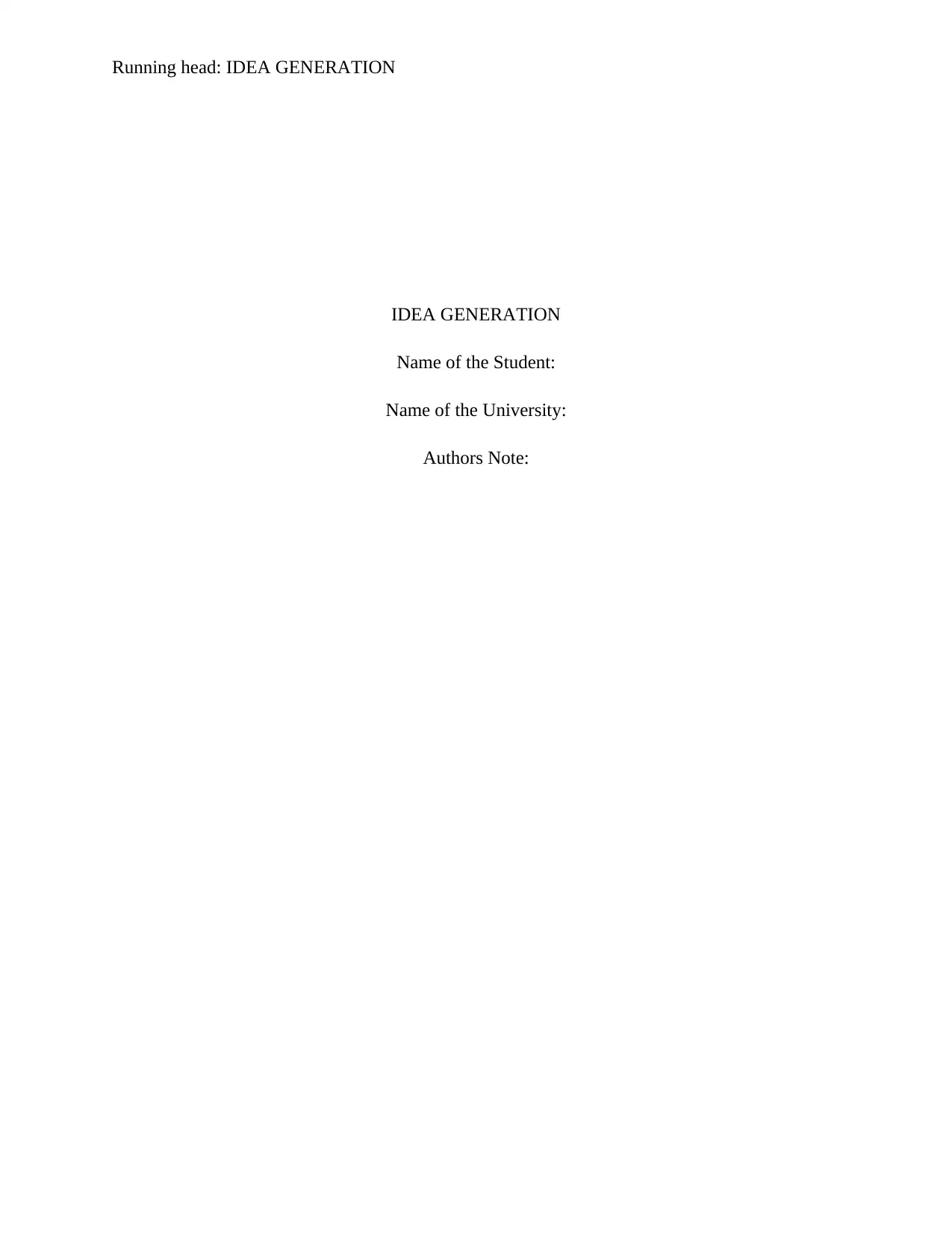
Running head: IDEA GENERATION
IDEA GENERATION
Name of the Student:
Name of the University:
Authors Note:
IDEA GENERATION
Name of the Student:
Name of the University:
Authors Note:
Paraphrase This Document
Need a fresh take? Get an instant paraphrase of this document with our AI Paraphraser
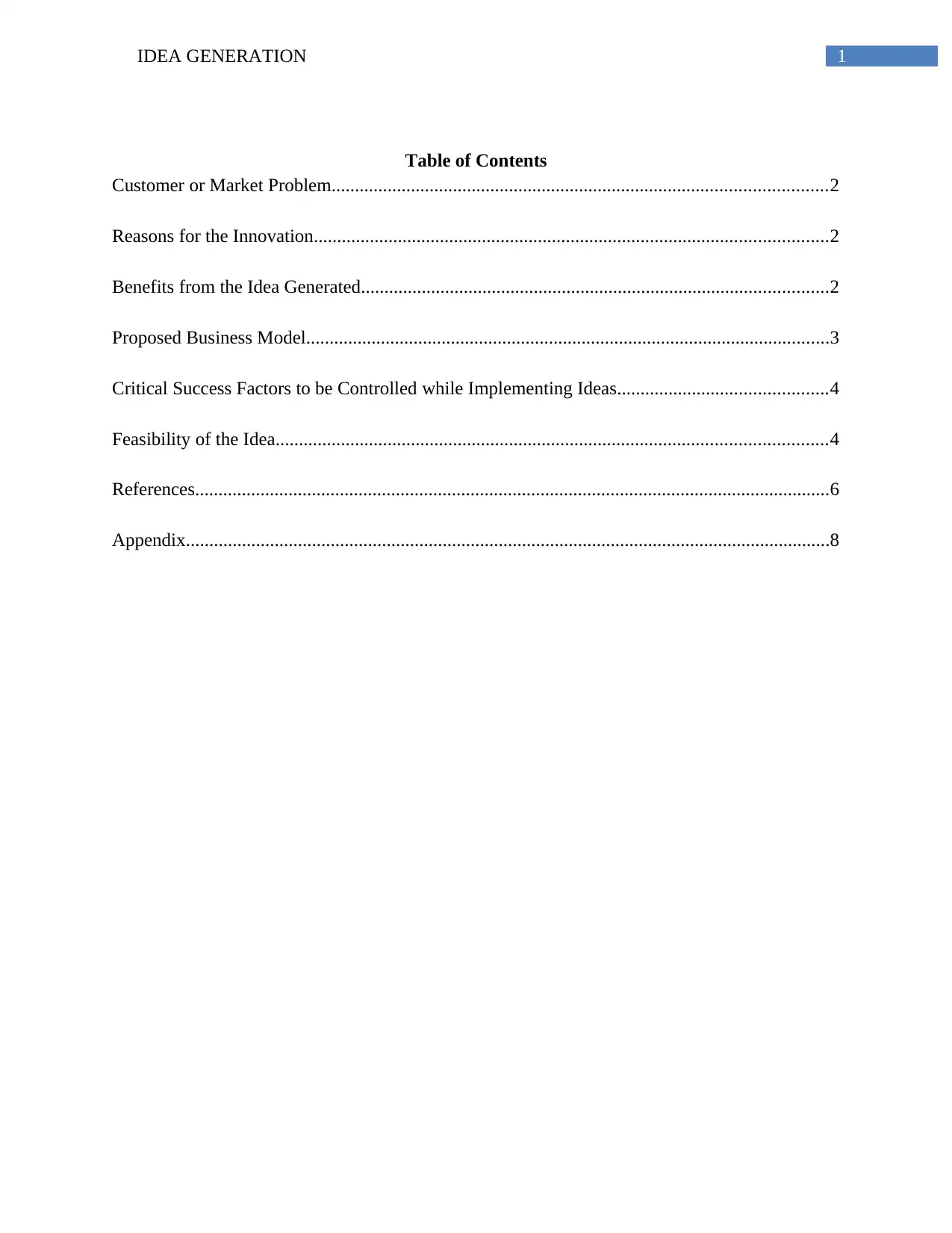
1IDEA GENERATION
Table of Contents
Customer or Market Problem..........................................................................................................2
Reasons for the Innovation..............................................................................................................2
Benefits from the Idea Generated....................................................................................................2
Proposed Business Model................................................................................................................3
Critical Success Factors to be Controlled while Implementing Ideas.............................................4
Feasibility of the Idea......................................................................................................................4
References........................................................................................................................................6
Appendix..........................................................................................................................................8
Table of Contents
Customer or Market Problem..........................................................................................................2
Reasons for the Innovation..............................................................................................................2
Benefits from the Idea Generated....................................................................................................2
Proposed Business Model................................................................................................................3
Critical Success Factors to be Controlled while Implementing Ideas.............................................4
Feasibility of the Idea......................................................................................................................4
References........................................................................................................................................6
Appendix..........................................................................................................................................8
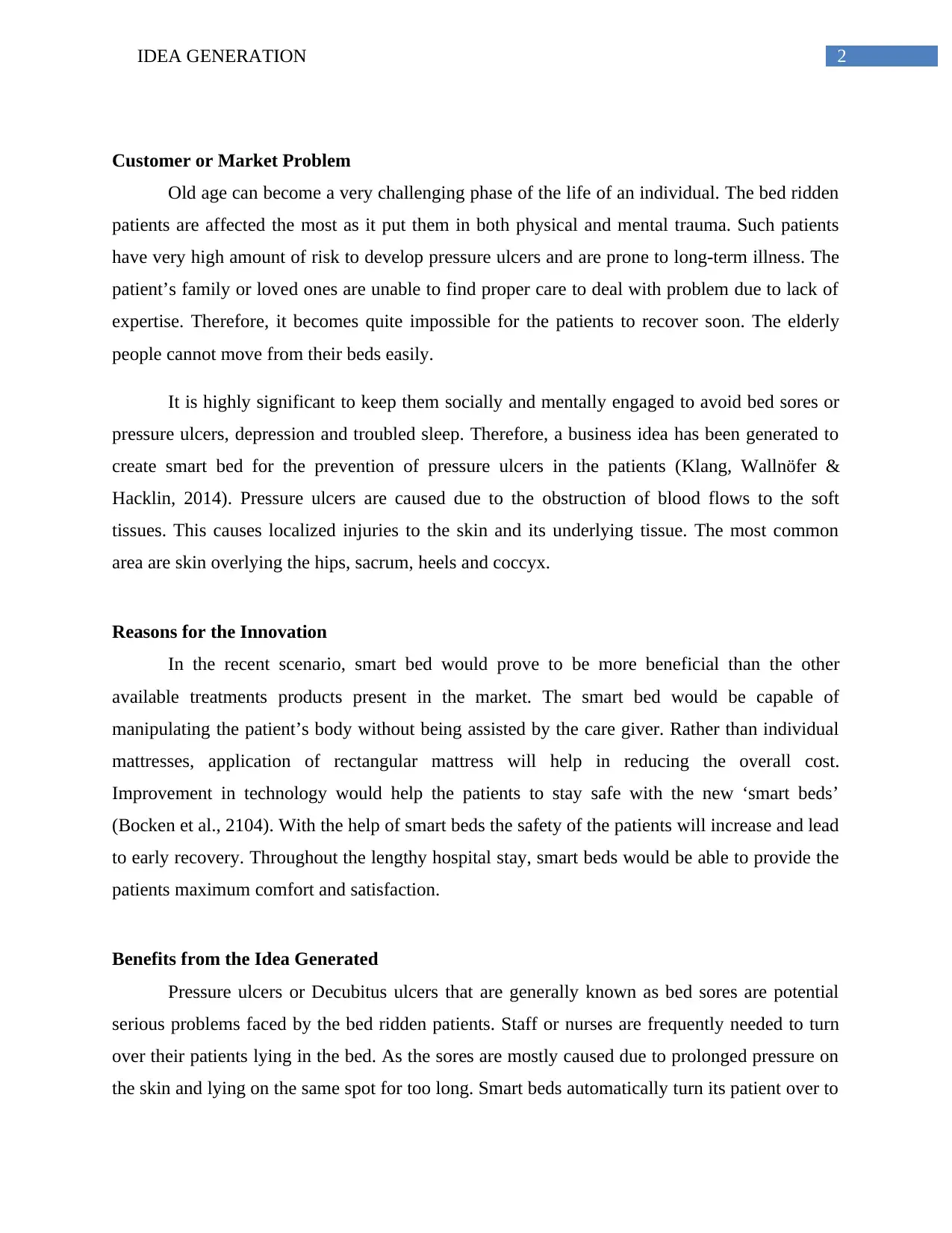
2IDEA GENERATION
Customer or Market Problem
Old age can become a very challenging phase of the life of an individual. The bed ridden
patients are affected the most as it put them in both physical and mental trauma. Such patients
have very high amount of risk to develop pressure ulcers and are prone to long-term illness. The
patient’s family or loved ones are unable to find proper care to deal with problem due to lack of
expertise. Therefore, it becomes quite impossible for the patients to recover soon. The elderly
people cannot move from their beds easily.
It is highly significant to keep them socially and mentally engaged to avoid bed sores or
pressure ulcers, depression and troubled sleep. Therefore, a business idea has been generated to
create smart bed for the prevention of pressure ulcers in the patients (Klang, Wallnöfer &
Hacklin, 2014). Pressure ulcers are caused due to the obstruction of blood flows to the soft
tissues. This causes localized injuries to the skin and its underlying tissue. The most common
area are skin overlying the hips, sacrum, heels and coccyx.
Reasons for the Innovation
In the recent scenario, smart bed would prove to be more beneficial than the other
available treatments products present in the market. The smart bed would be capable of
manipulating the patient’s body without being assisted by the care giver. Rather than individual
mattresses, application of rectangular mattress will help in reducing the overall cost.
Improvement in technology would help the patients to stay safe with the new ‘smart beds’
(Bocken et al., 2104). With the help of smart beds the safety of the patients will increase and lead
to early recovery. Throughout the lengthy hospital stay, smart beds would be able to provide the
patients maximum comfort and satisfaction.
Benefits from the Idea Generated
Pressure ulcers or Decubitus ulcers that are generally known as bed sores are potential
serious problems faced by the bed ridden patients. Staff or nurses are frequently needed to turn
over their patients lying in the bed. As the sores are mostly caused due to prolonged pressure on
the skin and lying on the same spot for too long. Smart beds automatically turn its patient over to
Customer or Market Problem
Old age can become a very challenging phase of the life of an individual. The bed ridden
patients are affected the most as it put them in both physical and mental trauma. Such patients
have very high amount of risk to develop pressure ulcers and are prone to long-term illness. The
patient’s family or loved ones are unable to find proper care to deal with problem due to lack of
expertise. Therefore, it becomes quite impossible for the patients to recover soon. The elderly
people cannot move from their beds easily.
It is highly significant to keep them socially and mentally engaged to avoid bed sores or
pressure ulcers, depression and troubled sleep. Therefore, a business idea has been generated to
create smart bed for the prevention of pressure ulcers in the patients (Klang, Wallnöfer &
Hacklin, 2014). Pressure ulcers are caused due to the obstruction of blood flows to the soft
tissues. This causes localized injuries to the skin and its underlying tissue. The most common
area are skin overlying the hips, sacrum, heels and coccyx.
Reasons for the Innovation
In the recent scenario, smart bed would prove to be more beneficial than the other
available treatments products present in the market. The smart bed would be capable of
manipulating the patient’s body without being assisted by the care giver. Rather than individual
mattresses, application of rectangular mattress will help in reducing the overall cost.
Improvement in technology would help the patients to stay safe with the new ‘smart beds’
(Bocken et al., 2104). With the help of smart beds the safety of the patients will increase and lead
to early recovery. Throughout the lengthy hospital stay, smart beds would be able to provide the
patients maximum comfort and satisfaction.
Benefits from the Idea Generated
Pressure ulcers or Decubitus ulcers that are generally known as bed sores are potential
serious problems faced by the bed ridden patients. Staff or nurses are frequently needed to turn
over their patients lying in the bed. As the sores are mostly caused due to prolonged pressure on
the skin and lying on the same spot for too long. Smart beds automatically turn its patient over to
⊘ This is a preview!⊘
Do you want full access?
Subscribe today to unlock all pages.

Trusted by 1+ million students worldwide
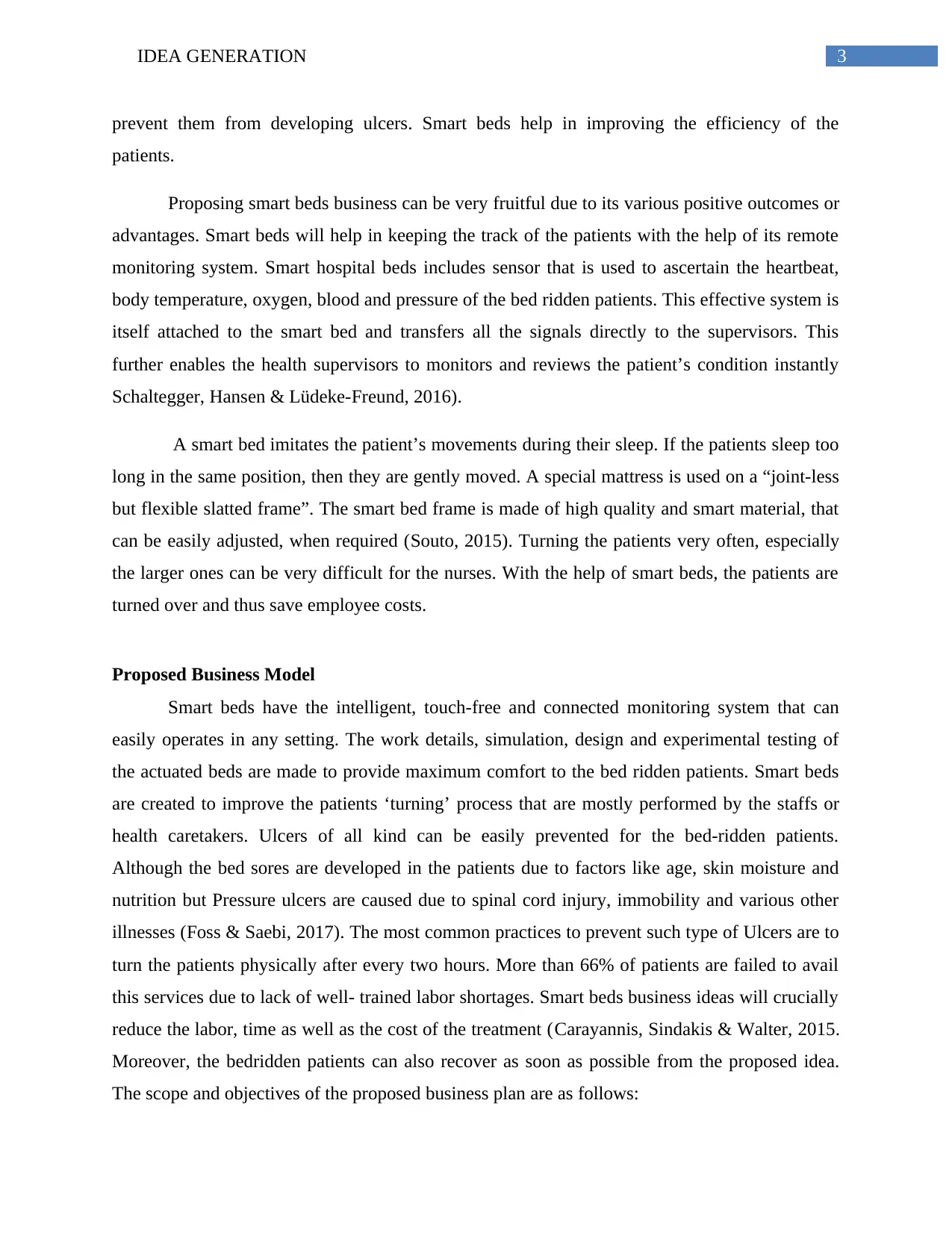
3IDEA GENERATION
prevent them from developing ulcers. Smart beds help in improving the efficiency of the
patients.
Proposing smart beds business can be very fruitful due to its various positive outcomes or
advantages. Smart beds will help in keeping the track of the patients with the help of its remote
monitoring system. Smart hospital beds includes sensor that is used to ascertain the heartbeat,
body temperature, oxygen, blood and pressure of the bed ridden patients. This effective system is
itself attached to the smart bed and transfers all the signals directly to the supervisors. This
further enables the health supervisors to monitors and reviews the patient’s condition instantly
Schaltegger, Hansen & Lüdeke-Freund, 2016).
A smart bed imitates the patient’s movements during their sleep. If the patients sleep too
long in the same position, then they are gently moved. A special mattress is used on a “joint-less
but flexible slatted frame”. The smart bed frame is made of high quality and smart material, that
can be easily adjusted, when required (Souto, 2015). Turning the patients very often, especially
the larger ones can be very difficult for the nurses. With the help of smart beds, the patients are
turned over and thus save employee costs.
Proposed Business Model
Smart beds have the intelligent, touch-free and connected monitoring system that can
easily operates in any setting. The work details, simulation, design and experimental testing of
the actuated beds are made to provide maximum comfort to the bed ridden patients. Smart beds
are created to improve the patients ‘turning’ process that are mostly performed by the staffs or
health caretakers. Ulcers of all kind can be easily prevented for the bed-ridden patients.
Although the bed sores are developed in the patients due to factors like age, skin moisture and
nutrition but Pressure ulcers are caused due to spinal cord injury, immobility and various other
illnesses (Foss & Saebi, 2017). The most common practices to prevent such type of Ulcers are to
turn the patients physically after every two hours. More than 66% of patients are failed to avail
this services due to lack of well- trained labor shortages. Smart beds business ideas will crucially
reduce the labor, time as well as the cost of the treatment (Carayannis, Sindakis & Walter, 2015.
Moreover, the bedridden patients can also recover as soon as possible from the proposed idea.
The scope and objectives of the proposed business plan are as follows:
prevent them from developing ulcers. Smart beds help in improving the efficiency of the
patients.
Proposing smart beds business can be very fruitful due to its various positive outcomes or
advantages. Smart beds will help in keeping the track of the patients with the help of its remote
monitoring system. Smart hospital beds includes sensor that is used to ascertain the heartbeat,
body temperature, oxygen, blood and pressure of the bed ridden patients. This effective system is
itself attached to the smart bed and transfers all the signals directly to the supervisors. This
further enables the health supervisors to monitors and reviews the patient’s condition instantly
Schaltegger, Hansen & Lüdeke-Freund, 2016).
A smart bed imitates the patient’s movements during their sleep. If the patients sleep too
long in the same position, then they are gently moved. A special mattress is used on a “joint-less
but flexible slatted frame”. The smart bed frame is made of high quality and smart material, that
can be easily adjusted, when required (Souto, 2015). Turning the patients very often, especially
the larger ones can be very difficult for the nurses. With the help of smart beds, the patients are
turned over and thus save employee costs.
Proposed Business Model
Smart beds have the intelligent, touch-free and connected monitoring system that can
easily operates in any setting. The work details, simulation, design and experimental testing of
the actuated beds are made to provide maximum comfort to the bed ridden patients. Smart beds
are created to improve the patients ‘turning’ process that are mostly performed by the staffs or
health caretakers. Ulcers of all kind can be easily prevented for the bed-ridden patients.
Although the bed sores are developed in the patients due to factors like age, skin moisture and
nutrition but Pressure ulcers are caused due to spinal cord injury, immobility and various other
illnesses (Foss & Saebi, 2017). The most common practices to prevent such type of Ulcers are to
turn the patients physically after every two hours. More than 66% of patients are failed to avail
this services due to lack of well- trained labor shortages. Smart beds business ideas will crucially
reduce the labor, time as well as the cost of the treatment (Carayannis, Sindakis & Walter, 2015.
Moreover, the bedridden patients can also recover as soon as possible from the proposed idea.
The scope and objectives of the proposed business plan are as follows:
Paraphrase This Document
Need a fresh take? Get an instant paraphrase of this document with our AI Paraphraser
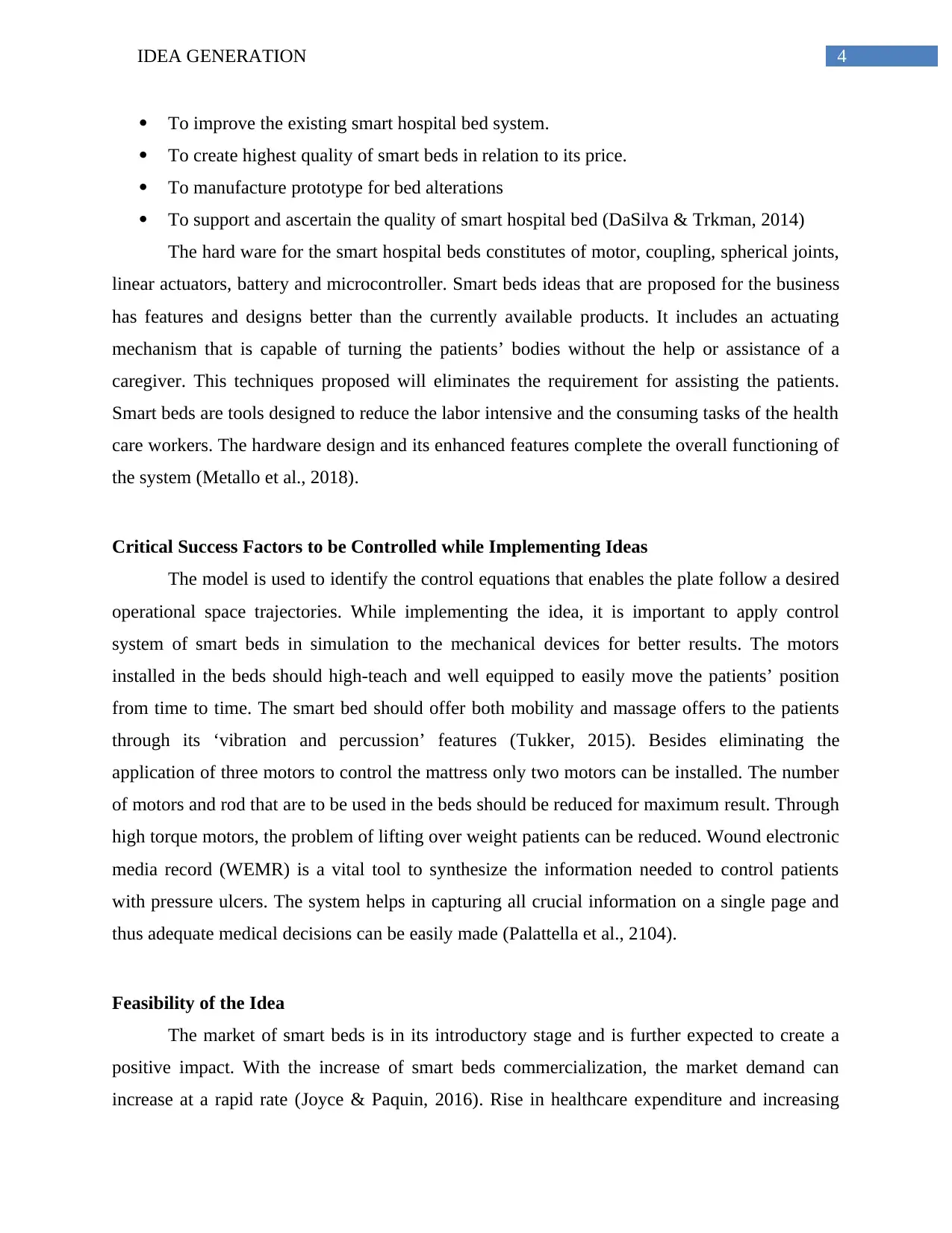
4IDEA GENERATION
To improve the existing smart hospital bed system.
To create highest quality of smart beds in relation to its price.
To manufacture prototype for bed alterations
To support and ascertain the quality of smart hospital bed (DaSilva & Trkman, 2014)
The hard ware for the smart hospital beds constitutes of motor, coupling, spherical joints,
linear actuators, battery and microcontroller. Smart beds ideas that are proposed for the business
has features and designs better than the currently available products. It includes an actuating
mechanism that is capable of turning the patients’ bodies without the help or assistance of a
caregiver. This techniques proposed will eliminates the requirement for assisting the patients.
Smart beds are tools designed to reduce the labor intensive and the consuming tasks of the health
care workers. The hardware design and its enhanced features complete the overall functioning of
the system (Metallo et al., 2018).
Critical Success Factors to be Controlled while Implementing Ideas
The model is used to identify the control equations that enables the plate follow a desired
operational space trajectories. While implementing the idea, it is important to apply control
system of smart beds in simulation to the mechanical devices for better results. The motors
installed in the beds should high-teach and well equipped to easily move the patients’ position
from time to time. The smart bed should offer both mobility and massage offers to the patients
through its ‘vibration and percussion’ features (Tukker, 2015). Besides eliminating the
application of three motors to control the mattress only two motors can be installed. The number
of motors and rod that are to be used in the beds should be reduced for maximum result. Through
high torque motors, the problem of lifting over weight patients can be reduced. Wound electronic
media record (WEMR) is a vital tool to synthesize the information needed to control patients
with pressure ulcers. The system helps in capturing all crucial information on a single page and
thus adequate medical decisions can be easily made (Palattella et al., 2104).
Feasibility of the Idea
The market of smart beds is in its introductory stage and is further expected to create a
positive impact. With the increase of smart beds commercialization, the market demand can
increase at a rapid rate (Joyce & Paquin, 2016). Rise in healthcare expenditure and increasing
To improve the existing smart hospital bed system.
To create highest quality of smart beds in relation to its price.
To manufacture prototype for bed alterations
To support and ascertain the quality of smart hospital bed (DaSilva & Trkman, 2014)
The hard ware for the smart hospital beds constitutes of motor, coupling, spherical joints,
linear actuators, battery and microcontroller. Smart beds ideas that are proposed for the business
has features and designs better than the currently available products. It includes an actuating
mechanism that is capable of turning the patients’ bodies without the help or assistance of a
caregiver. This techniques proposed will eliminates the requirement for assisting the patients.
Smart beds are tools designed to reduce the labor intensive and the consuming tasks of the health
care workers. The hardware design and its enhanced features complete the overall functioning of
the system (Metallo et al., 2018).
Critical Success Factors to be Controlled while Implementing Ideas
The model is used to identify the control equations that enables the plate follow a desired
operational space trajectories. While implementing the idea, it is important to apply control
system of smart beds in simulation to the mechanical devices for better results. The motors
installed in the beds should high-teach and well equipped to easily move the patients’ position
from time to time. The smart bed should offer both mobility and massage offers to the patients
through its ‘vibration and percussion’ features (Tukker, 2015). Besides eliminating the
application of three motors to control the mattress only two motors can be installed. The number
of motors and rod that are to be used in the beds should be reduced for maximum result. Through
high torque motors, the problem of lifting over weight patients can be reduced. Wound electronic
media record (WEMR) is a vital tool to synthesize the information needed to control patients
with pressure ulcers. The system helps in capturing all crucial information on a single page and
thus adequate medical decisions can be easily made (Palattella et al., 2104).
Feasibility of the Idea
The market of smart beds is in its introductory stage and is further expected to create a
positive impact. With the increase of smart beds commercialization, the market demand can
increase at a rapid rate (Joyce & Paquin, 2016). Rise in healthcare expenditure and increasing
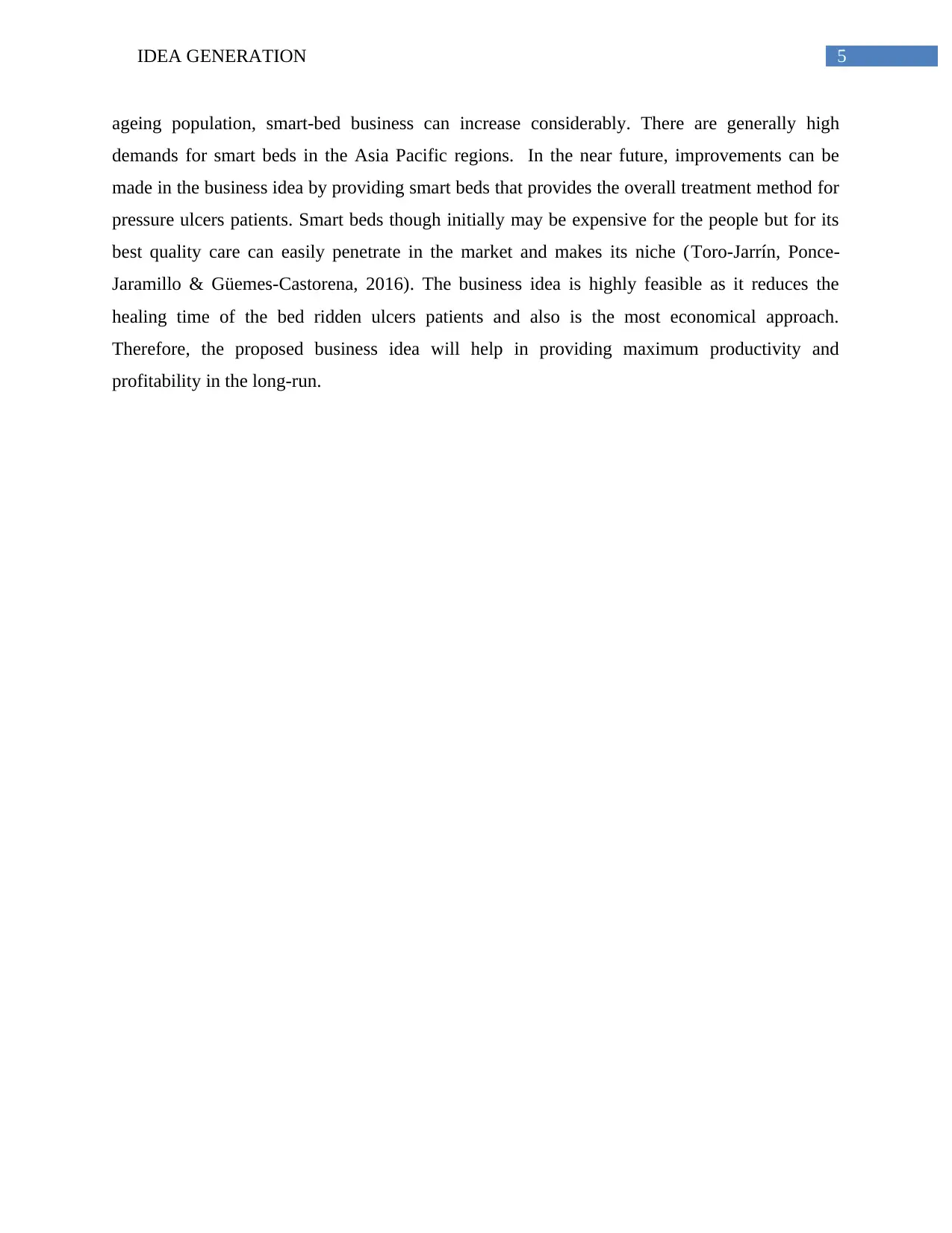
5IDEA GENERATION
ageing population, smart-bed business can increase considerably. There are generally high
demands for smart beds in the Asia Pacific regions. In the near future, improvements can be
made in the business idea by providing smart beds that provides the overall treatment method for
pressure ulcers patients. Smart beds though initially may be expensive for the people but for its
best quality care can easily penetrate in the market and makes its niche (Toro-Jarrín, Ponce-
Jaramillo & Güemes-Castorena, 2016). The business idea is highly feasible as it reduces the
healing time of the bed ridden ulcers patients and also is the most economical approach.
Therefore, the proposed business idea will help in providing maximum productivity and
profitability in the long-run.
ageing population, smart-bed business can increase considerably. There are generally high
demands for smart beds in the Asia Pacific regions. In the near future, improvements can be
made in the business idea by providing smart beds that provides the overall treatment method for
pressure ulcers patients. Smart beds though initially may be expensive for the people but for its
best quality care can easily penetrate in the market and makes its niche (Toro-Jarrín, Ponce-
Jaramillo & Güemes-Castorena, 2016). The business idea is highly feasible as it reduces the
healing time of the bed ridden ulcers patients and also is the most economical approach.
Therefore, the proposed business idea will help in providing maximum productivity and
profitability in the long-run.
⊘ This is a preview!⊘
Do you want full access?
Subscribe today to unlock all pages.

Trusted by 1+ million students worldwide
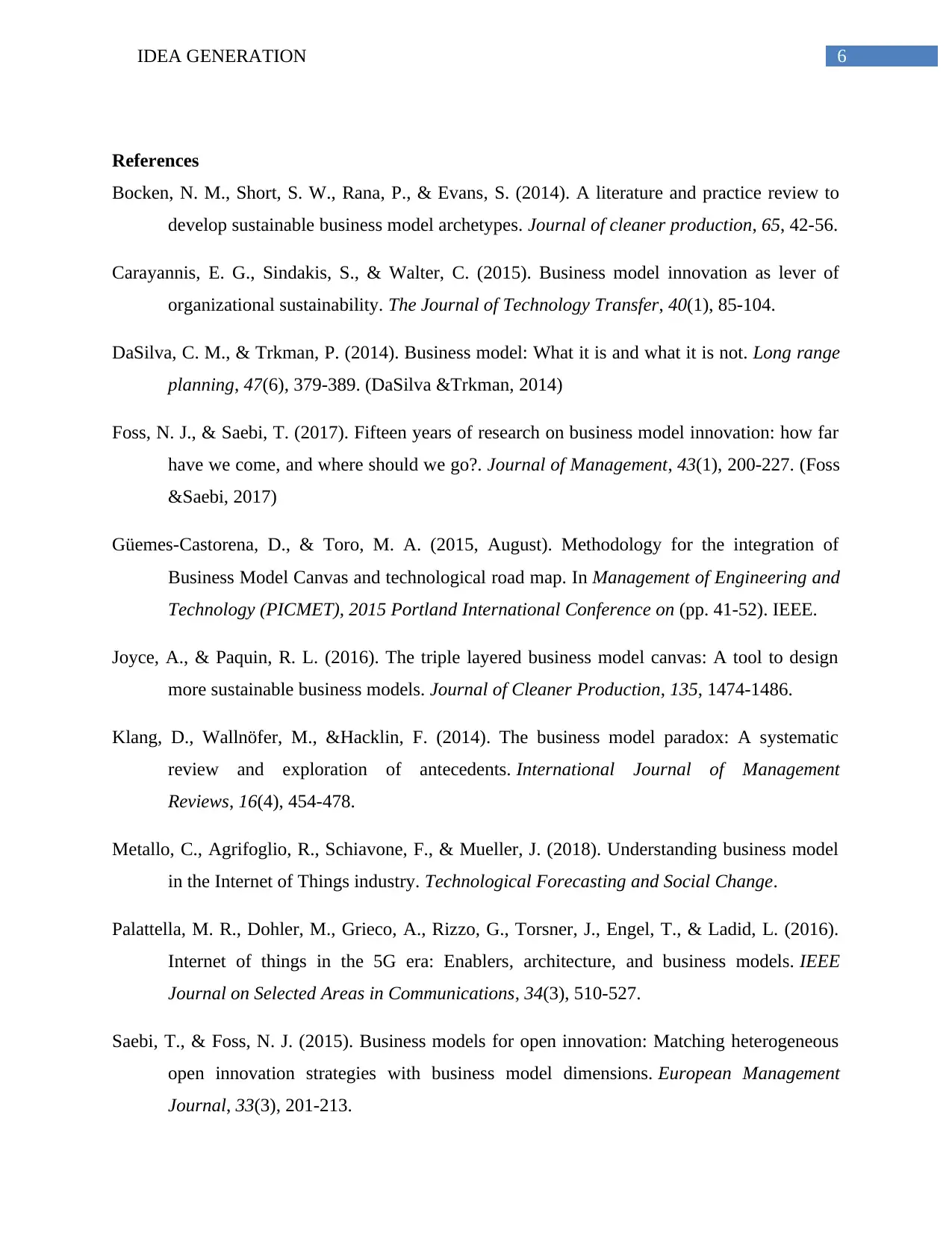
6IDEA GENERATION
References
Bocken, N. M., Short, S. W., Rana, P., & Evans, S. (2014). A literature and practice review to
develop sustainable business model archetypes. Journal of cleaner production, 65, 42-56.
Carayannis, E. G., Sindakis, S., & Walter, C. (2015). Business model innovation as lever of
organizational sustainability. The Journal of Technology Transfer, 40(1), 85-104.
DaSilva, C. M., & Trkman, P. (2014). Business model: What it is and what it is not. Long range
planning, 47(6), 379-389. (DaSilva &Trkman, 2014)
Foss, N. J., & Saebi, T. (2017). Fifteen years of research on business model innovation: how far
have we come, and where should we go?. Journal of Management, 43(1), 200-227. (Foss
&Saebi, 2017)
Güemes-Castorena, D., & Toro, M. A. (2015, August). Methodology for the integration of
Business Model Canvas and technological road map. In Management of Engineering and
Technology (PICMET), 2015 Portland International Conference on (pp. 41-52). IEEE.
Joyce, A., & Paquin, R. L. (2016). The triple layered business model canvas: A tool to design
more sustainable business models. Journal of Cleaner Production, 135, 1474-1486.
Klang, D., Wallnöfer, M., &Hacklin, F. (2014). The business model paradox: A systematic
review and exploration of antecedents. International Journal of Management
Reviews, 16(4), 454-478.
Metallo, C., Agrifoglio, R., Schiavone, F., & Mueller, J. (2018). Understanding business model
in the Internet of Things industry. Technological Forecasting and Social Change.
Palattella, M. R., Dohler, M., Grieco, A., Rizzo, G., Torsner, J., Engel, T., & Ladid, L. (2016).
Internet of things in the 5G era: Enablers, architecture, and business models. IEEE
Journal on Selected Areas in Communications, 34(3), 510-527.
Saebi, T., & Foss, N. J. (2015). Business models for open innovation: Matching heterogeneous
open innovation strategies with business model dimensions. European Management
Journal, 33(3), 201-213.
References
Bocken, N. M., Short, S. W., Rana, P., & Evans, S. (2014). A literature and practice review to
develop sustainable business model archetypes. Journal of cleaner production, 65, 42-56.
Carayannis, E. G., Sindakis, S., & Walter, C. (2015). Business model innovation as lever of
organizational sustainability. The Journal of Technology Transfer, 40(1), 85-104.
DaSilva, C. M., & Trkman, P. (2014). Business model: What it is and what it is not. Long range
planning, 47(6), 379-389. (DaSilva &Trkman, 2014)
Foss, N. J., & Saebi, T. (2017). Fifteen years of research on business model innovation: how far
have we come, and where should we go?. Journal of Management, 43(1), 200-227. (Foss
&Saebi, 2017)
Güemes-Castorena, D., & Toro, M. A. (2015, August). Methodology for the integration of
Business Model Canvas and technological road map. In Management of Engineering and
Technology (PICMET), 2015 Portland International Conference on (pp. 41-52). IEEE.
Joyce, A., & Paquin, R. L. (2016). The triple layered business model canvas: A tool to design
more sustainable business models. Journal of Cleaner Production, 135, 1474-1486.
Klang, D., Wallnöfer, M., &Hacklin, F. (2014). The business model paradox: A systematic
review and exploration of antecedents. International Journal of Management
Reviews, 16(4), 454-478.
Metallo, C., Agrifoglio, R., Schiavone, F., & Mueller, J. (2018). Understanding business model
in the Internet of Things industry. Technological Forecasting and Social Change.
Palattella, M. R., Dohler, M., Grieco, A., Rizzo, G., Torsner, J., Engel, T., & Ladid, L. (2016).
Internet of things in the 5G era: Enablers, architecture, and business models. IEEE
Journal on Selected Areas in Communications, 34(3), 510-527.
Saebi, T., & Foss, N. J. (2015). Business models for open innovation: Matching heterogeneous
open innovation strategies with business model dimensions. European Management
Journal, 33(3), 201-213.
Paraphrase This Document
Need a fresh take? Get an instant paraphrase of this document with our AI Paraphraser
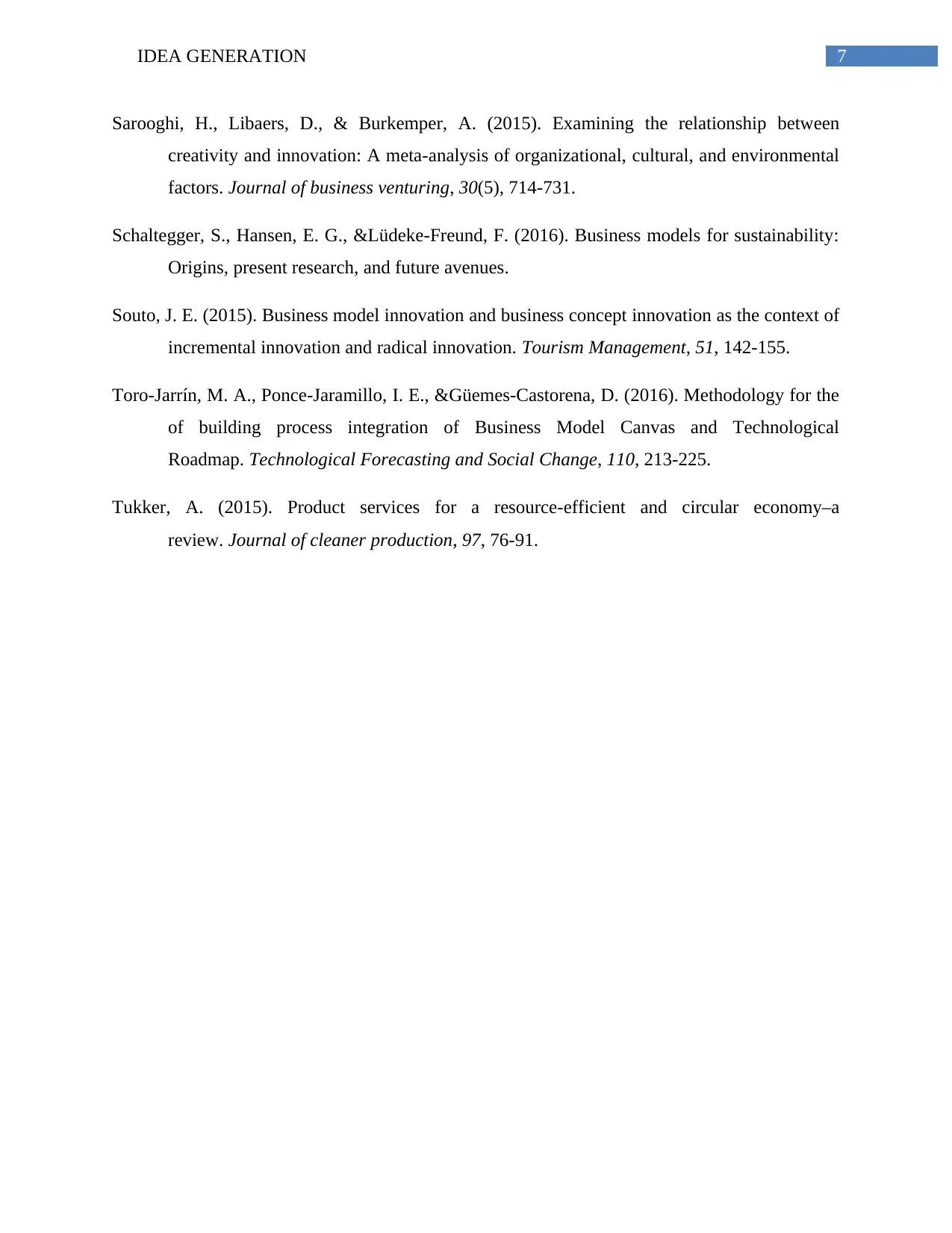
7IDEA GENERATION
Sarooghi, H., Libaers, D., & Burkemper, A. (2015). Examining the relationship between
creativity and innovation: A meta-analysis of organizational, cultural, and environmental
factors. Journal of business venturing, 30(5), 714-731.
Schaltegger, S., Hansen, E. G., &Lüdeke-Freund, F. (2016). Business models for sustainability:
Origins, present research, and future avenues.
Souto, J. E. (2015). Business model innovation and business concept innovation as the context of
incremental innovation and radical innovation. Tourism Management, 51, 142-155.
Toro-Jarrín, M. A., Ponce-Jaramillo, I. E., &Güemes-Castorena, D. (2016). Methodology for the
of building process integration of Business Model Canvas and Technological
Roadmap. Technological Forecasting and Social Change, 110, 213-225.
Tukker, A. (2015). Product services for a resource-efficient and circular economy–a
review. Journal of cleaner production, 97, 76-91.
Sarooghi, H., Libaers, D., & Burkemper, A. (2015). Examining the relationship between
creativity and innovation: A meta-analysis of organizational, cultural, and environmental
factors. Journal of business venturing, 30(5), 714-731.
Schaltegger, S., Hansen, E. G., &Lüdeke-Freund, F. (2016). Business models for sustainability:
Origins, present research, and future avenues.
Souto, J. E. (2015). Business model innovation and business concept innovation as the context of
incremental innovation and radical innovation. Tourism Management, 51, 142-155.
Toro-Jarrín, M. A., Ponce-Jaramillo, I. E., &Güemes-Castorena, D. (2016). Methodology for the
of building process integration of Business Model Canvas and Technological
Roadmap. Technological Forecasting and Social Change, 110, 213-225.
Tukker, A. (2015). Product services for a resource-efficient and circular economy–a
review. Journal of cleaner production, 97, 76-91.
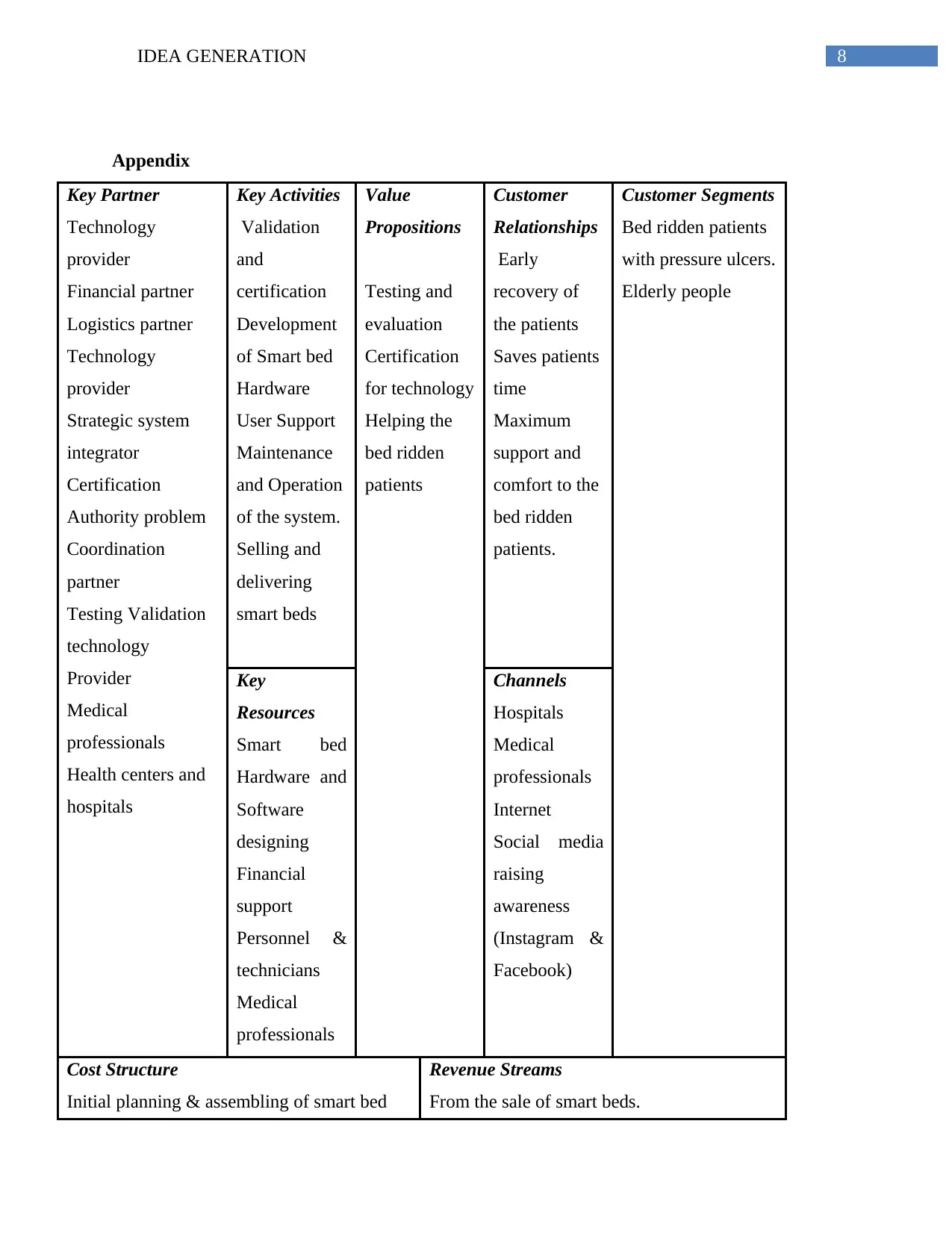
8IDEA GENERATION
Appendix
Key Partner
Technology
provider
Financial partner
Logistics partner
Technology
provider
Strategic system
integrator
Certification
Authority problem
Coordination
partner
Testing Validation
technology
Provider
Medical
professionals
Health centers and
hospitals
Key Activities
Validation
and
certification
Development
of Smart bed
Hardware
User Support
Maintenance
and Operation
of the system.
Selling and
delivering
smart beds
Value
Propositions
Testing and
evaluation
Certification
for technology
Helping the
bed ridden
patients
Customer
Relationships
Early
recovery of
the patients
Saves patients
time
Maximum
support and
comfort to the
bed ridden
patients.
Customer Segments
Bed ridden patients
with pressure ulcers.
Elderly people
Key
Resources
Smart bed
Hardware and
Software
designing
Financial
support
Personnel &
technicians
Medical
professionals
Channels
Hospitals
Medical
professionals
Internet
Social media
raising
awareness
(Instagram &
Facebook)
Cost Structure
Initial planning & assembling of smart bed
Revenue Streams
From the sale of smart beds.
Appendix
Key Partner
Technology
provider
Financial partner
Logistics partner
Technology
provider
Strategic system
integrator
Certification
Authority problem
Coordination
partner
Testing Validation
technology
Provider
Medical
professionals
Health centers and
hospitals
Key Activities
Validation
and
certification
Development
of Smart bed
Hardware
User Support
Maintenance
and Operation
of the system.
Selling and
delivering
smart beds
Value
Propositions
Testing and
evaluation
Certification
for technology
Helping the
bed ridden
patients
Customer
Relationships
Early
recovery of
the patients
Saves patients
time
Maximum
support and
comfort to the
bed ridden
patients.
Customer Segments
Bed ridden patients
with pressure ulcers.
Elderly people
Key
Resources
Smart bed
Hardware and
Software
designing
Financial
support
Personnel &
technicians
Medical
professionals
Channels
Hospitals
Medical
professionals
Internet
Social media
raising
awareness
(Instagram &
Facebook)
Cost Structure
Initial planning & assembling of smart bed
Revenue Streams
From the sale of smart beds.
⊘ This is a preview!⊘
Do you want full access?
Subscribe today to unlock all pages.

Trusted by 1+ million students worldwide
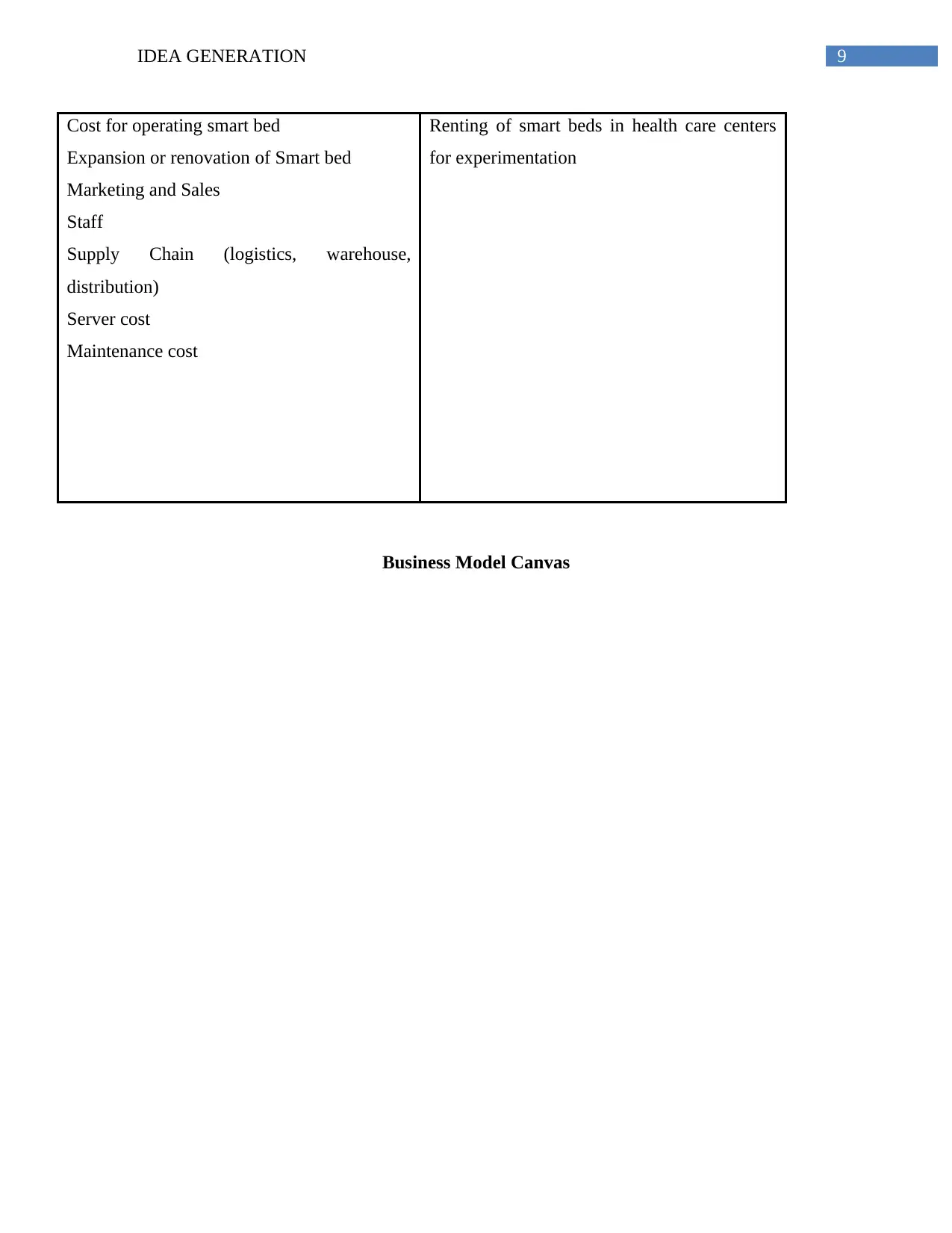
9IDEA GENERATION
Cost for operating smart bed
Expansion or renovation of Smart bed
Marketing and Sales
Staff
Supply Chain (logistics, warehouse,
distribution)
Server cost
Maintenance cost
Renting of smart beds in health care centers
for experimentation
Business Model Canvas
Cost for operating smart bed
Expansion or renovation of Smart bed
Marketing and Sales
Staff
Supply Chain (logistics, warehouse,
distribution)
Server cost
Maintenance cost
Renting of smart beds in health care centers
for experimentation
Business Model Canvas
1 out of 10
Related Documents
Your All-in-One AI-Powered Toolkit for Academic Success.
+13062052269
info@desklib.com
Available 24*7 on WhatsApp / Email
![[object Object]](/_next/static/media/star-bottom.7253800d.svg)
Unlock your academic potential
Copyright © 2020–2025 A2Z Services. All Rights Reserved. Developed and managed by ZUCOL.




